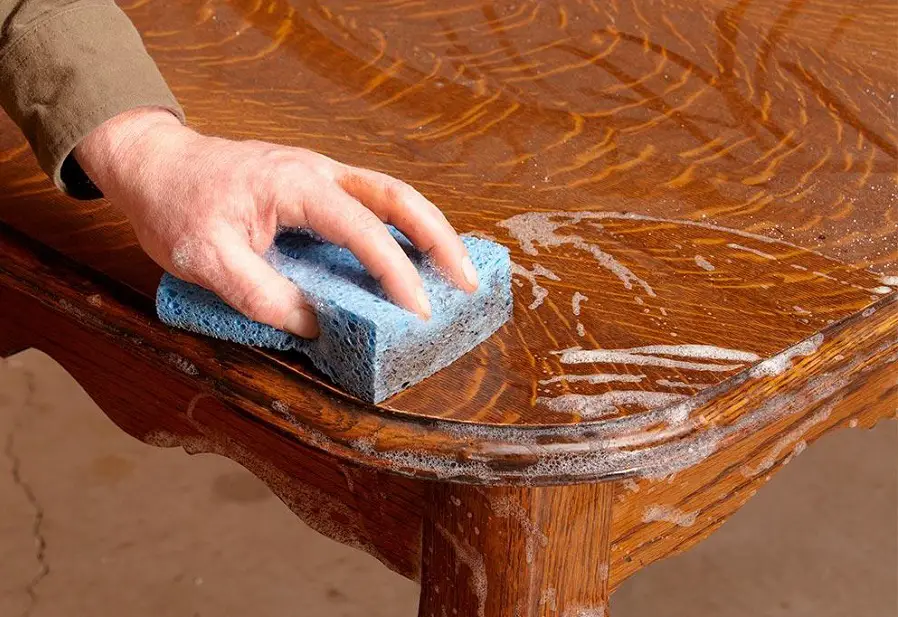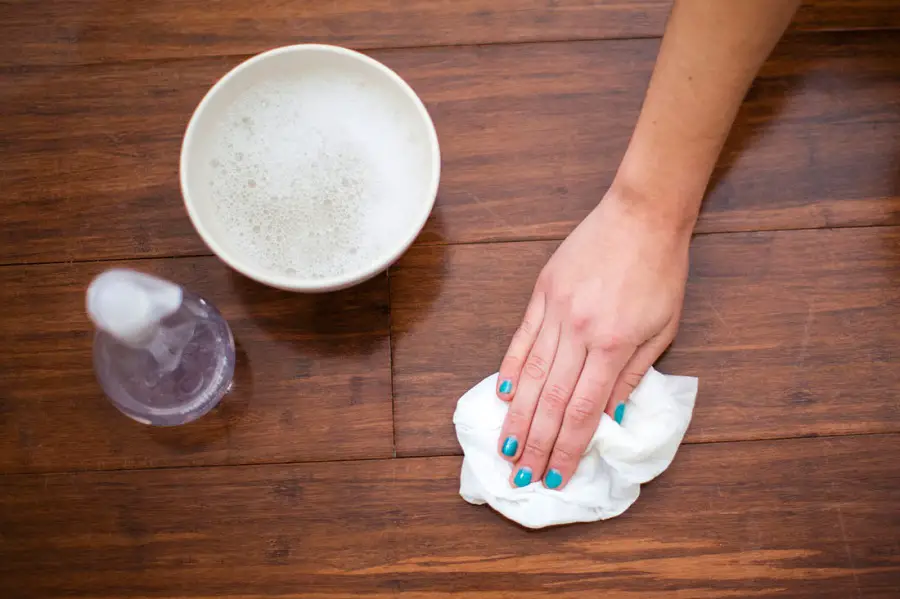There is an idea that wooden furniture or wooden floors cannot be cleaned with natural products because they are not aggressive enough. Especially when we are dealing with old furniture on which dust mixed with grease and soot has settled over time. We think of using modern cleaning products because they are the only way to achieve the perfect clean we want. I think that is not so. Drawing a parallel with doing the laundry, I don't think I have ever seen laundry as bright white as my grandmother used to wash it, in the white-washing bed, with rainwater and homemade soap made from soda and leftover pig fat. So while we are trying to eat as naturally as possible and use clothes made from natural fibers, I don't think it's a bad idea to see what natural cleaning and maintenance materials we can use.

Cleaning furniture
The simplest and most effective natural solution for cleaning wooden furniture or floors is soap and water. You will say that water should not get on furniture covered with varnish or paint because it bleaches and damages it. This is only true if the water remains on the varnished surface for a long period of time, and only in the case of certain varnishes (nitrocellulose, shellac). If you've had your furniture bleach find here some simple and handy solutions to get rid of stains. If the water is wiped off quickly and doesn't remain to soak in, your furniture won't suffer.
When washing furniture with soap and water it is good to make the soap solution first. In this way the furniture will be cleaned evenly and there will be no pieces of undissolved soap left on it. To make the solution, dissolve shaved soap in warm water. 2-3 tablespoons of shaved soap in 5 liters of water is enough. Then wash thoroughly all over with a soft cloth, paying particular attention to the areas where the dirt is more difficult to remove. A cotton cloth is recommended to avoid scratching the furniture. Finally, wipe the furniture very well with the dry cloth and leave to dry. Do not rush with the idea that the varnish will whiten immediately. You can safely leave the damp cloth on a stain for 5-10 minutes, as it is more difficult to remove. The important thing is that the furniture is thoroughly wiped and dry.
You can use any kind of soap, but since we're talking natural, homemade soap or commercially available natural soap is best. Marseille soapwhich you can find at Naturalpaintis a very good solution. Made from olive oil and various tree oils, it is especially for cleaning and maintaining furniture, floors and other wooden objects. It can also be used to protect with soap - a natural finish with a concentrated soap solution that find a full description here.

Options for more aggressive cleaning
There are times when no matter how hard we try, we can't remove dirt with just soap and water. Grease or paint stains, old grease mixed with soot need more aggressive solutions to remove them. The classic option is to use paint strippers or aggressive organic solvents.
These products are very aggressive and contain very harmful chlorine-based solvents (methylene chloride). Their use can damage your eyes, skin, respiratory tract or nervous system. So what is the alternative?
We use vinegar, lemon juice and baking soda. These are the simplest and most effective solutions for cleaning grease. You can also use them successfully for dishes (where gritty salt can act as an abrasive). Vinegar can also be used separately (diluted with water) or mixed with bicarbonate. So can lemon juice. An effervescent (cake-like) reaction occurs when mixing. Once it subsides, you can use the solution to clean dirty surfaces.

If vinegar and bicarbonate don't help either, you can turn to more aggressive natural alternatives based on soda or calcium carbonate (lime), but without the side effects that can occur years later. Pickling paste and soda of the Kreidezeit are such products. Pickling paste contains industrial soap, limescale, alkalis and fermentation alcohol. It is very effective for cleaning natural oil-based and alkyd paints. But not for modern varnishes such as polyurethane.
Soda is used for removing old layers of paint, softening varnished surfaces, cleaning them, removing fungus and mold. It has a sterilizing effect, absorbs odours and neutralizes acids.

Natural solutions for maintenance
After cleaning, surfaces should be protected. Ceara is the most used variant. It can be applied to any varnished, painted or oiled surface and if polished will give a satin sheen and a nice satin finish.
For natural protection, solutions based on beeswax, palm wax or carnauba wax are very effective. Carnauba wax is extracted from the leaves of a Brazilian palm species. The wax protects the tree's leaves against both excess water in rainy periods and dehydration in hot, dry periods.
Don't assume that all commercial wax-based products are natural. There are synthetic waxes and many commercial products contain them. If you want natural products always check the label and make sure that the composition is fully described.
Also for surface protection, after cleaning you can use a simple to make solution. Mix 150 ml olive oil with 50 ml white wine vinegar and a teaspoon of lemon juice. Put everything in a jar with a lid and shake well. Apply the solution to the furniture with a cotton cloth, buffing gently. It's a great protective solution that also fades white marks or scratches. You can add a few drops of essential oils or a few lavender leaves to the solution for a pleasant smell in your home.
If you're a fan of natural solutions, I hope the above suggestions will help.




































Hello, I bought a beautiful table, but it is veneered. I expect that it is not treated and at the first glass of water or wine spilled, it "wrinkles". Please give me, if possible, some advice on what I could use to treat the surface of the table, to get as much protection from moisture. Would a paste made from beeswax, olive oil and turpentine be sufficient? Thank you antiicipat
Hello!
Good moisture protection is obtained oil. Tung oil or combinations containing tung oil are best because they form a film. Linseed oil protects only in depth. Left on the surface, it does not dry out and remains sticky.
The paste you mention can protect, but to a lesser extent than the above solutions.
Oil and wax guarding samples are less resistant to staining (red wine, coffee) or scratching and mechanical damage. To have such resistance you need to use varnishes. The most resistant are those with chemical curing (polyurethane, water-based, acetyl).
In the case of the table you bought, if it has not been protected with oil, wax or varnish, the danger of spilling a glass of water or wine is that the veneer will stain and come off. If it's not protected it's best to do it as soon as possible. Lightly sand the surface with a medium abrasive sponge before applying any finish.
All the best!
Hello. I have stained a wooden floor in wenghe and I would like to open it to color, how should I proceed?thanks
Hello!
Light colours are the hardest. The possibilities would be as follows:
- if it is plain bath, not dye or a bath containing resin, bleach with sodium hypochlorite (classic laundry bleach), hydrogen peroxide (perhydrol) or other chemicals that attack colours. If the floor is oak, avoid ammonia and its derivatives because it reacts with tannins and stains brown. There is a link at the end that might help you,
- sanding down to wood and recolouring with a lighter colour,
- coating with a paint (not varnish) in the desired colour. The colour will be fully coated in the same way as the wood grain. If you don't give many coats so the film is not thick, the wood design will be visible.
- a special effect to lighten the colour, sort of distressed (you have the link below). Sand the color without removing it completely even if you get to the wood sometimes. Cover with a thin coat of white, cream, grey or other light colour (paint) that you think is suitable. Sand the color after drying so that the bottom coat starts to show through. Cover everything with colourless floor varnish. It depends a lot on inspiration, talent, artistic inclination and taste.
Good luck!
https://revistadinlemn.ro/2017/04/19/albirea-si-decolorarea-lemnului-dupa-indepartarea-vechiului-finisaj/
https://revistadinlemn.ro/2016/09/06/distress-metoda-invechire-mobilei/